Community-based instruction is sustained and repeated instruction that takes place in the community rather than in the school building (Baker & Freeman, 2014). It is a research-based practice that provides “real-life” opportunities to teach functional life skills as well as aspects of the New Jersey State Learning Standards (Radwan, 2018). Many students with disabilities have difficulty transferring knowledge and skills learned in school to other, more natural environments (Steere & DiPipi-Hoy, 2012). However, by affording students the opportunity to participate in community-based instruction (CBI), special education teachers are able to continue to individualize instruction, promote independence, and support the social, emotional and behavioral skills necessary to function as productive members of the community (Beakley, Yoder, & West, 2003).

Kaitlin Eberhardt, MA, BCBA, LBA-NYS

Chrissy Filozof, BCaBA
Hernandez and Kulkarni (2018) remind us that beginning the process of teaching functional life-skills at an early age often leads to a smoother transition into community living later in life. The Freehold Township School District provides students in grades Pre-K through 8 structured experiences to practice and implement skills acquired in the classroom out in a community setting. More specifically, student IEP goals are addressed via program implementation in the school setting and are then generalized to environments outside of our four walls. Additionally, whenever possible, staff take the opportunity to teach loosely, and work on skills out in the community that have not yet been mastered in school. After all, research tells us that varying the instructional setting, materials, environment, etc. is one of the most effective ways to promote generalization of skills and learning across all environments (Baer, Wolf, & Risley, 1987; Stokes & Baer, 1977).
In our district, selected staff members have received specialized training from the State of New Jersey Department of Education and have provided turn-key training to the self-contained special education teachers, related service providers, and support staff who work with students every day. The goal of our CBI program is to begin preparing our students with disabilities the skills and strategies necessary to succeed as independently as possible. This type of instruction ultimately transitions with students from preschool and elementary school to middle school in our district and begins preparing them for career awareness and career exploration opportunities once they move on to high school. The functional activities curated by each teacher allow students to practice the skills necessary to become a productive member of the Freehold Township community later in life – which qualitative data indicate is a common goal among the families we serve. The following is an overview of the community-based instruction program in Freehold Township, New Jersey, including how it was established, how it is implemented in order to best support our students’ needs, and the changes we have made in the face of a global pandemic.
Internal Structure and Support
Pickens and Dymond (2015) indicate support from school administration is one of the biggest variables in determining whether or not a community-based instructional program will be successful. The knowledge and resources they bring to the table often prove to be invaluable when it comes to paving the way for students to find their place in the community (Radwan, 2018; Preus, 2012).
In Freehold Township, our CBI program is facilitated by our Director of Educational Services, Mrs. Robyn Klim. The administrator’s role is a critical component as they provide the approval for the entire program including policies and procedures, approval of trips, transportation, and budget. To assist with the infrastructure, our director has assigned one of the Child Study Team secretaries as the CBI Coordinator. Her responsibilities include making reservations if necessary, organizing transportation, managing budget, and creating a shared CBI calendar for all the trips planned in the district. This allows for the possibility for student/s in one school to join a trip with student/s at another school.
The special education teacher’s role is key for a successful program for the students. Teachers’ responsibilities include identifying target students and number of staff needed to support them (e.g., group size), obtaining parental input and feedback, identifying community locations and how many visits will be needed for repeated practice, and identifying relevant IEP objectives to be targeted in the community. The teacher also considers what skills the student has acquired in the classroom that need to be generalized to the community setting, and what current objectives can be taught functionally in the natural environment. It is important to note, specific CBI goals and objectives are not written for students’ IEPs. Therapists, such as speech, OT and PT also play an important role in community-based instruction. Their expertise should be utilized for identifying places to visit as well as IEP objectives that should be targeted.
Funding
As stated above, our Educational Services Department budget supports most of our CBI trips. Last year, gift cards were purchased for sit-down restaurants and purchase orders were used to pay ahead for birthday party places (e.g., bowling alleys, trampoline parks) and the movie theater. Additionally, we are fortunate to have a special needs PTO in Freehold Township, the Parent Advisory Council for Excellence (PACE), which has graciously donated funds to our CBI program. This has allowed special education teachers to provide older students with a debit card or cash at some stores and fast food restaurants, so they can practice money skills in a functional way.
There are also many creative ways to get around budgeting issues, should they arise: asking parents/guardians to send in cash and a list of items for their child to buy and bring home; allowing school staff to “place an order” for specific items (and pay ahead of time) so that students can shop with staff money and deliver completed orders to their classroom; planning trips where students do not have the option to make a purchase, and practice tolerating “no”; applying for special needs grants; and asking local businesses if they would donate time or resources to your program. By building a community connection in this way, families of our special needs children are often more comfortable visiting the wonderful, inclusive establishments we partner with, which in turn, helps improve their quality of life as well.
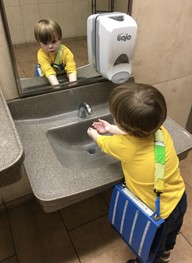
Washing hands before eating
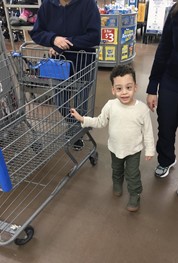
Holding onto the shopping cart
Description of Programs
Freehold Township CBI is broken down into three parts – a preschool program, elementary program, and middle school program. During the 2019-2020 school year, trips were scheduled twice per month for each group to provide sustained and repeated practice for IEP objectives as well as other important focus areas.
Our preschool program, known as “Preschoolers Around Town,” consists of self-contained students aged 3-5 years old engaging in activities related to community awareness and exploration. Focus areas at this level often include safety skills, language and communication skills, social skills, and behavior management.
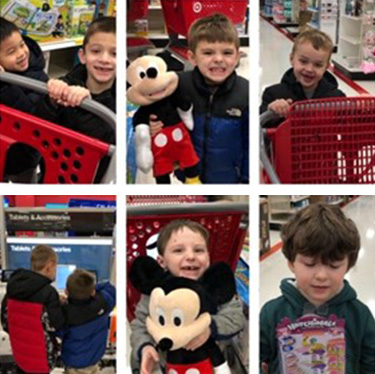
Shopping at our local Target
At the elementary level, self-contained students in grades K-5 are divided into two grade groups: K-2 and 3-5. Although these two groups attend similar locations (big box / grocery stores, sit down restaurants, movies, etc.), different skills are targeted at each. For example, at big box / grocery stores, students in grades K-2 often practice staying near an adult or tolerating not buying an item, whereas students in grades 3-5 often practice following a shopping list and purchasing items with either cash or a debit card. Finally, some students in these grades have the opportunity to organize a school snack and coffee cart. Examples of skills practiced during these times include following recipes to make snacks, social and communications skills, and specific money skills.
At the middle school level, self-contained students in grades 6-8 participate in similar outings, with the addition of other community events that are scheduled for the public to attend (beach sweep, torch run, etc.). Some of the focus areas for these students include shopping and money skills, changing their behavior for fast food v. sit-down restaurants, safety and navigation skills, social perspective taking, decision making, tolerating changes, and expanding their repertoire of leisure skills.
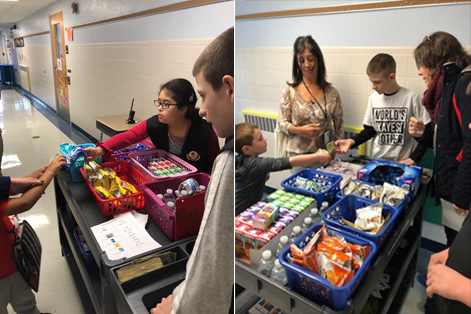
Middle School snack sale
Data-Driven Instruction and Evidence-Based Decisions
Similar to any other type of instruction, CBI relies heavily on planning and preparation. Teachers often report one of the most beneficial activities when designing community-based instruction is looking at a student’s IEP, along with the survey collected regarding parent concerns, and the list of approved locations for the year. Then, teachers determine which objectives can be targeted at each location, given the types of activities that might be performed there. It should be noted, this does not mean each IEP objective is targeted on each trip, to each location, for each student. It simply gives a starting point for planning what, when, and how skills will be targeted. Teachers and service providers often quickly realize there is quite a bit of overlap, and many more opportunities for learning than they anticipated. Over the course of a school year, data for student-specific IEP goals are collected during these instructional outings and graphed so teachers may monitor progress across time. Additionally, notes regarding the generalization of these skills and performance out in the community are often included in student progress reports throughout the year.
A key piece that differentiates community-based instruction from a field trip is that CBI includes the purposeful implementation of evidence-based teaching strategies, the use of prompts and prompt fading (including fading proximity of support staff), data collection and evaluation, and using data-driven decisions to help students acquire their goals. These components help teachers determine if a student’s performance is increasing, decreasing, or demonstrating no change across opportunities and time. Further, they allow staff to determine what level of support is needed for each student on a given day, and if and when it is appropriate to fade support in order to promote independence.
Finally, it is critical to remember the importance of including leisure activities in a community-based instruction program. Eratay (2013) reminds us that leisure activities often promote social development and decrease behavioral challenges. Anecdotally, we believe these activities also help our students learn about and develop their talents and gifts, expand their areas of interest, create friendships in the community, and improve their overall quality of life with regard to physical fitness, physical activity, and self-esteem.
Qualitative Data from Parent Surveys
Parent surveys are collected both prior to the onset of programming to determine student need, and upon completion of the year to determine parent perception of student improvement. In our pre-intervention survey, we ask parents to list three locations and the difficulty that their child has in that location. In the post-intervention survey, we ask parents to provide anecdotal data by selecting from the following choices: Greatly improved; Slight improvement; Remains a problem; Have not taken him/her to this place; as well as a section for additional comments. Results from the 2019-2020 school year indicate improvement was noted in 75% of post-survey comments. The other 25% of comments reflected that the child had not yet been taken back to the location due to the onset of COVID-19. We hope to return to those families and follow up once restrictions are lifted.
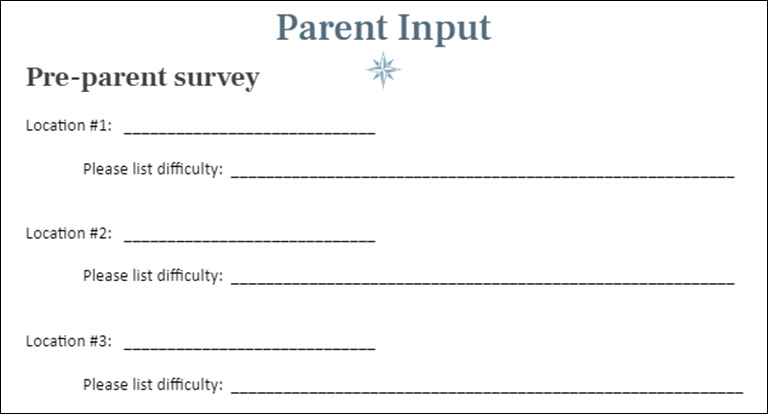
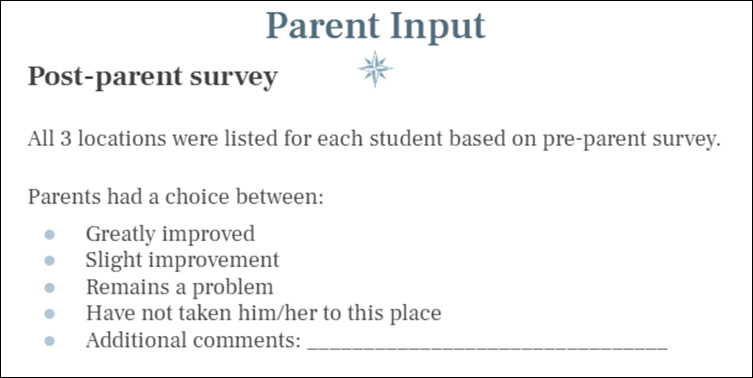
CBI During COVID-19
Understandably, while restrictions are in place due to COVID-19, our typical CBI program has been temporarily suspended. Despite these challenges, however, some of the brilliant men and women we work with have been brainstorming ways to bring the community to our students. In our preschool and lower elementary grades, staff are replicating environments and learning opportunities within the classroom (e.g., bowling, movies, sit-down restaurants – ordering and waiting for their snack). In the upper elementary grades and at the middle school level, we build on those same experiences with the addition of a class store as part of a class-wide reinforcement system, or the opportunity to assist with the school store.
One of the biggest projects, however, has been building a fully functional storefront within one of our middle school self-contained classrooms. The hope is that by creating this simulated environment, students will be able to continue practicing skills they have learned – whether it be measuring, social skills, following a visual schedule or recipe, money skills, requesting more items when needed, etc.- in something as close to the natural environment as possible.
Sample Target Areas / Skills for Community Instruction
Restaurants: Panera, Tony’s Grill, Bocos, Sweet Lew’s, Four Seasons, Burger King, Food Court
Social skills:
- Requesting
- Reciprocal conversation
- Courteous vocabulary
- Vocal volume
- Discussion making
- Wait time – in lines
- Ordering for yourself
- Advocating – needs and wants (refill)
- Picking up on social cues – when others get up
- Using Manners
Receptive Language:
- Following directions
- Introduction of novel, functional vocabulary
Expressive Language:
- Answering “wh” questions
- Asking “wh” questions
Concepts:
- Math concepts (adding, subtracting, counting)
- Money
- Do I have enough to order that?
- Prepositions (locative, sequential, temporal)
Functional (ADLs):
- Following community signs
- Acting appropriate in a restaurant and different types of restaurants.
- Decision making
Assistive Technology:
- Use of AAC/Communication devices
PT/OT:
- Carrying trays
- Chairs
- Moving through stores without bumping into things
- Walking through the mall without bumping into a person
We hope this has either encouraged readers to take steps toward developing a CBI program in their district or provided ideas for how to maintain a CBI program during COVID-19. If you have any questions or would like to discuss further, please feel free to contact any of the following: Robyn Klim, Director of Ed. Services – rklim@freeholdtwp.k12.nj.us; Chrissy Filozof, District Behavior Analyst – cfilozof@freeholdtwp.k12.nj.us, or Kait Eberhardt, District Behavior Analyst – kflinn@freeholdtwp.k12.nj.us
References
Baer, D. M., Wolf, M. M., & Risley, T. R. (1987). Some still-current dimensions of applied behavior analysis. Journal of Applied Behavior Analysis, 20(4), 313-327.
Baker, D., & Freeman, B. (2014). Administrators’ overview of the community-based instruction training series 2014-2015 school year [PowerPoint]. New Brunswick, NJ: The Boggs Center on Developmental Disabilities.
Beakley, B. A., Yoder, S. L., & West, L. L. (2003). Community-based instruction: A guidebook for teachers. Arlington, VA; Council for Exceptional Children.
Eratay, E. (2013). Effectiveness of leisure time activities program on social skills and behavior problems in individuals with intellectual disabilities. Education Research and Reviews, 8, 1437–1448.
Hernandez, C. & Kulkarni, S. S. (2018). Social skills and students with moderate disabilities: can community based instruction help? Journal of the American Academy of Special Education Professionals, Spring/Summer, 6-22.
Pickens, J. L., & Dymond, S. K. (2015). Special education directors’ views of community-based vocational instruction. Research and Practice for Person with Severe Disabilities, 39(4), 290-304.
Preus, B. (2012). Authentic instruction for 21st century learning: Higher order thinking in an inclusive school. American Secondary Education, 40(3), 59-79.
Radwan, S. (2018). Professional learning outcomes that teachers experience as a result of implementing a community-based instruction program: A qualitative case study. (Doctoral Dissertation). Retrieved from Proquest LLC.
Steere, D., & DiPipi-Hoy, C. (2012). When you can’t get out: Strategies for supporting community-based instruction. TEACHING Exceptional Children, 45(2), 60-67.
Stokes, T. M., & Baer, D. M. (1977). An implicit technology of generalization. Journal of Applied Behavior Analysis, 10(2), 349-367.




